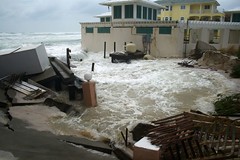This post is by Amy Hardberger, an attorney with EDF’s Texas Office’s Climate/Air and Water programs.
 Hurricane Ike storm surge hits Jetty East, by Flickr user eh3k.
Hurricane Ike storm surge hits Jetty East, by Flickr user eh3k.
For some, it’s hard to care about global warming because its impacts on everyday life aren’t obvious. It’s too abstract. It’s not tangible. It’s too wonky. It’s just not real enough.
Well, what if you learned that global warming could literally push you out of your home? Is that real enough for you?
Texas cities Houston and Galveston just got a wake-up call – conservative estimates of sea level rise due to climate change will displace 78 percent of households over the next 100 years in Galveston County alone, according to a new study that EDF and the British Consulate-General commissioned from the Harte Research Institute at Texas A&M Corpus Christi.
And that’s the conservative estimate. In a business-as-usual scenario, Galveston-area sea levels could rise as much as 1.5 meters in the next 100 years, which could displace more than 100,000 households and create more than $12 billion in infrastructure losses for Houston and Galveston. Rising sea levels will also damage at least 23 public facilities, industrial sites and water treatments plants, begging many questions about where to move or how to protect these sites. (See a related post on sea level rise.)
For cities like Galveston, which is still rebuilding from Hurricane Ike, these findings reinforce the notion that planning for how to adapt to climate changes or mitigate their effects is critical. Current discussions have centered around building a large, expensive and likely ineffective “Ike Dike” to protect the city from future storm surges, though there are likely more realistic adaptation measures that will make people safer quicker. Passing federal climate legislation and ramping up local municipal energy efficiency are surely the most effective ways to begin reducing the rate of sea level rise.
So, for all of you out there who don’t think global warming could happen to you, take a hard look at the harsh reality that these coastal communities face.









